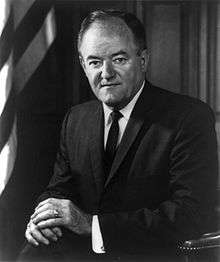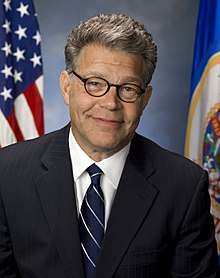Minnesota Democratic–Farmer–Labor Party
Minnesota Democratic–Farmer–Labor Party | |
|---|---|
 | |
| Chairman | Ken Martin |
| Governor | Mark Dayton |
| Senate leader | Tom Bakk |
| House leader | Melissa Hortman |
| Founded | April 15, 1944 |
| Merger of | Minnesota Democratic Party and Minnesota Farmer–Labor Party |
| Headquarters |
255 Plato Boulevard East Saint Paul |
| Youth wing | Minnesota Young DFL (MYDFL) |
| Ideology |
Modern liberalism Progressivism Factions: Social democracy Environmentalism Labor unionism |
| Political position | Center-left to left-wing[1] |
| National affiliation | Democratic Party |
| Colors | Blue |
| Senate |
33 / 67 |
| House of Representatives |
57 / 134 |
| U.S. Senate |
2 / 2 |
| U.S. House of Representatives |
5 / 8 |
| Website | |
|
www | |
The Minnesota Democratic–Farmer–Labor Party (DFL) is a socially liberal political party in the U.S. state of Minnesota. It is affiliated with the U.S. Democratic Party. Formed by a merger of the Minnesota Democratic Party and the social democratic Minnesota Farmer–Labor Party in 1944, the DFL is one of only two state Democratic party affiliates of a different name (the other being the North Dakota Democratic-Nonpartisan League Party).
History
The DFL was created on April 15, 1944, with the merger of the Minnesota Democratic Party and the Farmer–Labor Party. Leading the merger effort were Elmer Kelm, the head of the Minnesota Democratic Party and founding chairman of the DFL; Elmer Benson, effectively the head of the Farmer–Labor Party by virtue of his leadership of its dominant left-wing faction; and rising star Hubert H. Humphrey, who chaired the Fusion Committee that accomplished the union and then went on to chair its first state convention.
Orville Freeman was elected the state's first DFL governor in 1954. Important members of the party have included Minneapolis mayor Hubert H. Humphrey and Minnesota Attorney General Walter Mondale, who each went on to be United States Senators, Vice Presidents of the United States, and unsuccessful Democratic nominees for president, Humphrey in 1968 and Mondale in 1984; Eugene McCarthy, a U.S. senator who ran for the Democratic presidential nomination in 1968 as an anti-Vietnam War candidate; and Paul Wellstone, a U.S. senator from 1991 to 2002 who became an icon of populist progressivism.[2]
Current elected officials
Members of Congress
U.S. Senate
U.S. House of Representatives
State offices
State Legislature
Current leadership
- Chair: Ken Martin
- Vice Chair: Marge Hoffa
- Treasurer: Tyler Moroles
- Secretary: Jacob Grippen
- Outreach Officer: Shivanthi Sathanandan
See also
References
- ↑
- ↑ Loughlin, Sean (October 25, 2002). "Wellstone Made Mark as a Liberal Champion". CNN. Retrieved June 23, 2014.
Further reading
- Delton, Jennifer A. Making Minnesota Liberal: Civil Rights and the Transformation of the Democratic Party. Minneapolis: University of Minnesota Press, 2002.
- Haynes, John Earl. "Farm Coops and the Election of Hubert Humphrey to the Senate". Agricultural History 57, no. 2 (Fall 1983).
- Haynes, John Earl. Dubious Alliance: The Making of Minnesota's DFL Party. Minneapolis: University of Minnesota Press, 1984.
- Henrickson, Gary P. Minnesota in the 'McCarthy' Period": 1946–1954. Ph.D. diss. University of Minnesota, 1981.
- Lebedoff, David. The 21st Ballot: A Political Party Struggle in Minnesota. Minneapolis: University of Minnesota Press, 1969.
- Lebedoff, David. Ward Number Six. New York: Scribner, 1972. Discusses the entry of radicals into the DFL party in 1968.
- Mitau, G. Theodore. The Democratic–Farmer–Labor Party Schism of 1948. Minnesota History Magazine 34 (Spring 1955).
External links
| Wikimedia Commons has media related to Minnesota Democratic-Farmer-Labor Party. |

